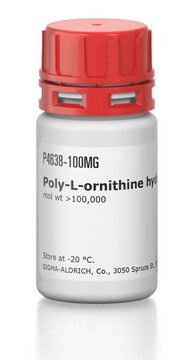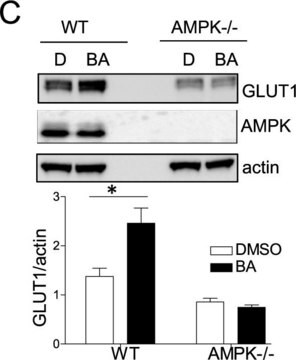P3655
Poly-L-ornithin -hydrobromid
suitable for cell culture, Mol wt 30,000-70,000
Synonym(e):
L-Ornithine homopolymer hydrobromide
About This Item
Empfohlene Produkte
Produktbezeichnung
Poly-L-ornithin -hydrobromid, mol wt 30,000-70,000
Form
powder
Qualitätsniveau
Mol-Gew.
30,000-70,000
Methode(n)
cell culture | mammalian: suitable
Farbe
white to off-white
Lagertemp.
−20°C
SMILES String
[Br-].NC(CCCN)C(=O)O.[H+]
InChI
1S/C5H12N2O2.BrH/c6-3-1-2-4(7)5(8)9;/h4H,1-3,6-7H2,(H,8,9);1H
InChIKey
GWRQMKDBBHFVIZ-UHFFFAOYSA-N
Suchen Sie nach ähnlichen Produkten? Aufrufen Leitfaden zum Produktvergleich
Anwendung
Biochem./physiol. Wirkung
Hinweis zur Analyse
Lagerklassenschlüssel
11 - Combustible Solids
WGK
WGK 3
Flammpunkt (°F)
Not applicable
Flammpunkt (°C)
Not applicable
Persönliche Schutzausrüstung
Eyeshields, Gloves, type N95 (US)
Hier finden Sie alle aktuellen Versionen:
Besitzen Sie dieses Produkt bereits?
In der Dokumentenbibliothek finden Sie die Dokumentation zu den Produkten, die Sie kürzlich erworben haben.
Kunden haben sich ebenfalls angesehen
progenitor cells from human cerebrospinal fluid in fetal
cystic myelomeningocele
Artikel
Humankind has utilized protein materials throughout its existence, starting with the use of materials such as wool and silk for warmth and protection from the elements and continuing with the use of recombinant DNA techniques to synthesize proteins with unique and useful properties.
Unser Team von Wissenschaftlern verfügt über Erfahrung in allen Forschungsbereichen einschließlich Life Science, Materialwissenschaften, chemischer Synthese, Chromatographie, Analytik und vielen mehr..
Setzen Sie sich mit dem technischen Dienst in Verbindung.









